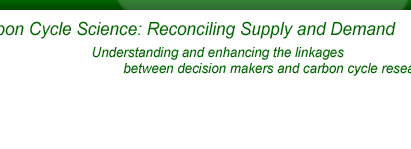 |
|
|
|
 |
|||||
|
|
|
|
|||||||
 |
|
|
|
|
|||||
 |
|||||||||
 |
|
|
|
|
Missed Opportunity Matrix
One way to understand the supply/demand dynamics is to examine a particular decision setting in the context of our ‘Missed Opportunity Matrix’. In so doing, we ask two questions:- Does the decision maker need information about the carbon cycle?
- Does the NACP target its research agenda on the information needs of the decision maker?
|
The missed Opportunities Matrix |
Does decision maker need information about the carbon cycle? | ||
|
YES |
NO | ||
| Does the NACP target its research agenda on the information needs of the decision maker? | YES | Sophisticated user | Missed opportunity |
| NO | Missed opportunity | Non-user | |
These two questions form, respectively, the ordinate and abscissa of our Missed Opportunity Matrix. Each of the four possible outcomes requires a unique focus from the standpoint of improving connections of supply and demand of carbon cycle science. For example, cases that involve decision makers who need information that the NACP is not providing requires different strategies for improved connections than a case where the NACP is providing scientific information that can inform decisions but that isn’t being used by decision makers. Use of the matrix will enable us to address several elements of the relation between the supply and demand side for carbon cycle science, including:
- The need to modify supply to address unmet demand-side needs for information
- The need to increase the receptivity of the demand side to existing or forthcoming scientific information that is potentially valuable but currently underutilized
- The need to identify new demand-side actors to take advantage of existing information that is currently underutilized
- The need for new process of communication between demand and supply sides.
In situations where the NACP targets its research to the needs of decision makers, and where decision makers use the information, the challenge is to evaluate the use of the information and to formalize mechanisms of ‘technology transfer’ and ‘technology assessment’ to facilitate effective use of carbon cycle science and to provide a feedback to the science program that helps to ensure that continued research provides useful information to decision makers.
In situations where the NACP is not producing information and the decision maker does not need carbon cycle information, the challenge is also to evaluate the use of information. Does the decision maker truly not need carbon cycle information? Is the NACP producing information that no one uses?
The remaining two quadrants represent situations in which supply and demand are mismatched, such as when decision makers need information that the NACP is not producing, or the NACP is producing the information but the decision maker is not using it. The challenge in these situations is on of reconciliation of needs with information, or information with needs.